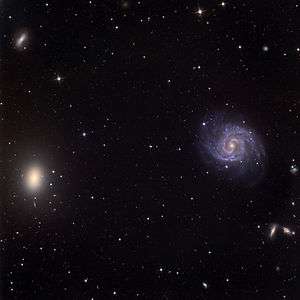NGC 1052
NGC 1052 is an elliptical galaxy in the constellation Cetus.
| NGC 1052 | |
|---|---|
 NGC 1052 (center left) and NGC 1042 (center right) as imaged by Schulman Telescope | |
| Observation data (J2000 epoch) | |
| Constellation | Cetus |
| Right ascension | 02h 41.1m[1] |
| Declination | −8° 15′ 21″[1] |
| Apparent magnitude (V) | 12.1[1] |
| Characteristics | |
| Type | E4[1] |
| Apparent size (V) | 3.0′ × 2.1′[1] |
Features
NGC 1052 is located at a distance of around 63 million light years from the Milky Way,[2] and has a LINER-type active galactic nucleus which signals the intense starburst activity in the galaxy's center[3] that were confirmed with observations with better resolution showing a number of star-forming regions and young star clusters.[4]
NGC 1052 shows also two small jets emerging from its nucleus as well as a very extended disc of neutral hydrogen, far larger than the galaxy itself,[5] all these features suggesting a gas-rich galaxy collided and merged with it 1 billion years ago producing all the above features.[4]
A scale image of NGC 1052 and its satellite galaxies is available at the reference.[6]
Central black hole
NGC 1052 hosts a rapidly rotating supermassive black hole with a mass of 154 million M☉[7] with a large magnetic field of between 0.02 and 8.3 Tesla, which, according to PhD student Anne-Kathrin Baczko, the leader of the team that made this discovery, provides enough magnetic energy to power the previously mentioned twin relativistic jets.
The location of this black hole is the most precisely known in the universe, with the exception of Sagittarius A*, the supermassive black hole found at the heart of our own galaxy.[8]
See also
- NGC 1052-DF2, a galaxy assumed to be associated with NGC 1052, and which appears to have little or no dark matter
- NGC 1052-DF4, another galaxy assumed to be associated with NGC 1052, and which appears to have little or no dark matter[9]
References
- "NASA/IPAC Extragalactic Database". Results for NGC 1052. Retrieved 2013-12-21.
- J. L. Tonry; A. Dressler; J.P. Blakeslee; E.A. Ajhar; A.B. Fletcher; G. A. Luppino; M. R. Metzger; C.B. Moore (2001). "The SBF Survey of Galaxy Distances. IV. SBF Magnitudes, Colors, and Distances". Astrophysical Journal. 546 (2): 681–693. arXiv:astro-ph/0011223. Bibcode:2001ApJ...546..681T. doi:10.1086/318301.
- Pierce, Michael; Brodie, Jean P.; Forbes, Duncan A.; Beasley, Michael A.; Proctor, Robert; Strader, Jay (2005). "The evolutionary history of the elliptical galaxy NGC 1052". Monthly Notices of the Royal Astronomical Society. 358 (1): 419–431. arXiv:astro-ph/0501066. Bibcode:2005MNRAS.358..419P. doi:10.1111/j.1365-2966.2005.08778.x.
- Fernández-Ontiveros, J.A.; López-Sanjuan, C.; Montes, M.; Prieto, M. A.; Acosta-Pulido, J.A. (2011). "The most recent burst of star formation in the massive elliptical galaxy NGC 1052". Monthly Notices of the Royal Astronomical Society Letters. 411 (1): L21–L25. arXiv:1011.2498. Bibcode:2011MNRAS.411L..21F. doi:10.1111/j.1745-3933.2010.00985.x.
- "Notes for NGC 1052". NED. Cal Tech.
- Dokkum, Pieter. "image of NGC 1052". twitter.
- Brenneman, L. W.; Weaver, K. A.; Kadler, M.; Tueller, J.; Marscher, A.; Ros, E.; Zensus, A.; Kovalev, Y.Y.; Aller, M.; Aller, H.; Irwin, J.; Kerp, J.; Kaufmann, S. (2009). "Spectral analysis of the accretion flow in NGC 1052 with Suzaku". The Astrophysical Journal. 698: 528–540. arXiv:0903.3583. doi:10.1088/0004-637X/698/1/528.
- "Twin jets pinpoint the heart of an active galaxy". phys.org. Retrieved 1 April 2018.
- Pieter van Dokkum, Shany Danieli, Roberto Abraham, Charlie Conroy, Aaron J. Romanowsky, "A second galaxy missing dark matter in the NGC1052 group" (Submitted on 17 Jan 2019) https://arxiv.org/abs/1901.05973